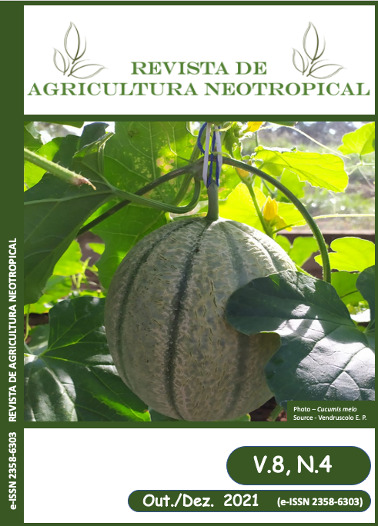ESSENTIAL OIL OF Mentha spicata REDUCES THE INITIAL GROWTH OF Corynespora cassiicola in vitro
DOI:
https://doi.org/10.32404/rean.v8i4.6375Keywords:
Phytopathology, fungicide resistance, alternative controlAbstract
Synthetic fungicides are one of the control strategies for the most common diseases in agriculture. However, more sustainable strategies are required. Thus, this study evaluates the potential of the essential oils of Cedrela fissilis and Mentha spicata in the in vitro control of the mycelial growth of the pathogen Corynespora cassiicola. The experiment was conducted at the Phytosanitary Laboratory of the Universidade Estadual do Mato Grosso do Sul (UEMS), University Unit of Cassilândia-MS. The essential oils of Argentine Cedar (Cedrela fissilis) and Spearmint (Mentha spicata) were acquired from commerce. A completely randomized design was used with a factorial scheme of two categories of essential oils (Spearmint and Cedar) x 5 concentrations (0, 25, 50, 100, and 200 μL L-1). The data were submitted to the analysis of variance. The means were compared by the Tukey test at 5% probability. Quantitative data were submitted to regression analysis. The fungicide effect was determined by measuring the diameter of colonies (mean of two diametrically opposed measurements, using a caliper, every 72 hours until reaching 216 hours). Spearmint essential oil (M. Spicata) presented higher efficiency than Argentine Cedar essential oil (Cedrela fissilis) on reducing of Corynespora cassiicola growth in the periods between 72 and 144 hours in vitro.
References
(I) Bayan, Y., Küsek, M. 2018. Chemical Composition and Antifungal and Antibacterial Activity of Mentha spicata L. Volatile Oil. International Journal of Agriculture and Natural Resources, 45(1), 64-69. DOI: http://dx.doi.org/10.7764/rcia.v45i1.1897.
(II) Carvalho, C.C.C.R., Fonseca, M.M.R. 2006. Carvone: why and how should one bother to produce this terpene. Food Chemistry, 95(3), 413-422. DOI: http://doi.org/10.1016/j.foodchem.2005.01.003.
(III) Dantigny, P., Nanguy, S.P.M. 2009. Significance of the physiological state of fungal spores. International Journal of Food Microbiology, 134(1-2), 16–20. DOI: http://doi.org/10.1016/j.ijfoodmicro.2009.02.005.
(IV) Diniz, S.P.S., Coelho, J.S., Rosa, G.S., Specian, V., Oliveira, R.C., Oliveira, R.R. 2008. Bio atividade do óleo essencial de Mentha arvensis L. no controle de fungos fitopatógenos. Revista Brasileira de Plantas Medicinais, 10(4), 9-11.
(V) Dixon, L.J., Schlub, R.L., Pernezny, K., Datnoff, L.E. 2009. Host specialization and phylogenetic diversity of Corynespora cassiicola. Phytopathology, 99(9), 1015–27.
(VI) Farr, D.F., Rossman, A.Y. 2018. Fungal Databases, U.S. National Fungus Collections, ARS, USDA. http://nt.ars-grin.gov/fungaldatabases (accessed August 1st, 2021).
(VII) Gwinn, K.D. 2018. Bioactive natural products in plant disease control. In: Atta-ur-Rahman (Ed). Studies in natural products chemistry. Elsevier B.V., Amsterdam, p.229–246.
(VIII) Kedia, A., Prakash B., Mishra, P.K., Chanotiya, C.S, 2014. Antifungal, antiaflatoxigenic, and insecticidal efficacy of spearmint (Mentha spicata L.) essential oil. International Biodeterioration and Biodegradation 89, 29-36. DOI: http://doi.org/10.1016/j.ibiod.2013.10.027.
(IX) Lucas, J. A., Hawkins, N. J., Fraaije, B. A. 2015. The evolution of fungicide resistance. Advances in Applied Microbiology, 90, 29-92. DOI: http://doi.org/10.1016/bs.aambs.2014.09.001.
(X) Marques, R.P., Monteiro, A.C., Pereira, G.T. 2004. Crescimento, esporulação e viabilidade de fungos entomopatogênico sem meios contendo diferentes concentrações do óleo de nim (Azadirachta indica).Ciência Rural, 34(6),1675-1680. DOI: http://doi.org/10.1590/S0103-84782004000600002.
(XI) Maróstica Junior, M.R., Pastore, G.M. 2007. Biotransformação de Limoneno: uma revisão das principais rotas metabólicas. Química Nova, 30(2), 382-387. DOI: http://doi.org/10.1590/S0100-40422007000200027.
(XII) Nogueira. T.S.R., Passos, M.S., Nascimento, L.P., Arantes, M.B.S., Monteiro, N.O., Boeno, S.I.S., Carvalho Junior, A., Azevedo, O.A., Terra, S., Vieira, M.G.C., Braz-Filho, R., Vieira, I.J.C. 2020. Chemical Compounds and Biologic Activities: A Review of Cedrela Genus. Molecules, 25(22), 5401. DOI: http://doi.org/10.3390/molecules25225401.
(XIII) Pereira, W.V., May-De-Mio, L.L. 2019. First report of Corynespora cassiicola causing leaf spot on Solanum americanum in Brazil. Journal of Plant Pathology, 101(4),755-755. DOI: http://doi.org/10.1007/s42161-018-00216-z.
(XIV) R Development Core Team. 2019. R. language definition. http://cran.rproject.org/doc/manuals/r-release/R-lang.pdf. (accessed August 1st, 2021).
(XV) Reuveni, M., Cohen, Y. R. 2020. Essential Tea Tree Oil Activity against Bremia lactucae in Lettuce. Agronomy, 10(6), 836. DOI: http://doi.org/10.3390/agronomy10060836.
(XVI) Santos, N.O., Mariane, B., Lago, J.H.G., Sartorelli, P., Rosa, W., Soares, M.G., Silva, A. M., Lorenzi, H., Vallim, M.A., Pascon, R.C. 2015. Assessing the Chemical Composition and Antimicrobial Activity of Essential Oils from Brazilian Plants - Eremanthus erythropappus (Asteraceae), Plectrantuns barbatus, and P. amboinicus (Lamiaceae). Molecules 20(5) 8440-8452. DOI: http://doi.org/10.3390/molecules20058440.
(XVII) Shahbazi, Y., Shavisi, N. 2016. Interactions of Ziziphora clinopodioides and Mentha spicata essential oils with chitosan and ciprofloxacin against common food-related pathogens. LWT-Food Science and Technology, 71, 364-369. DOI: http://doi.org/10.1016/j.lwt.2016.04.011.
(XVIII) Silva, A.G., Vieira, G.H.C., Melo, T.M.P., Faria, G.A., Silva, E.M. 2020. Extratos de Cedrela fissilis, Melia azedarach e Azadirachta indica em Polyphagotarsonemus latus. Research, Society and Development, 9(8), 125985455. DOI: http://dx.doi.org/10.33448/rsd-v9i8.5455.
(XIX) Singh, A.K., Dikshit, A., Sharma, M.L., Dixit, S.N. 1980.Fungitoxic activity of some essential oils. Economic Botany 34, 186–190. DOI: http://doi.org/10.1007/BF02858635.
(XX) Soares, R.M., Arias, C.A.A. 2020. Inheritance of soybean resistance to Corynespora cassiicola. Summa Phytopathologica, 46(2), 85-91. DOI: http://doi.org/10.1590/0100-5405/232903.
(XXI) Tan, Q.G.; Luo, X.D. 2011.Meliaceous Limonoids: Chemistry and Biological Activities. Chemical Review, 111 (11), 7437–7522. DOI: http://doi.org/10.1021/cr9004023.
(XXII) Teramoto, A.; Meyer, M.C.; Suassuna, N.D.; Cunha, M.G. 2017. In vitro sensitivity of Corynespora cassiicola isolated from soybean to fungicides and field chemical control of target spot. Summa Phytopathologica, 43(4), 281-289. DOI: http://doi.org/10.1590/0100-5405/2195
Downloads
Published
How to Cite
Issue
Section
License
The authors retain the rights to the manuscripts and, therefore, are free to share, copy, distribute, perform and publicly communicate the work under the following conditions:
Acknowledge work credits in the manner specified by the author or licensor (but not in a way that suggests that you have their support or that they support their use of their work).
REVISTA DE AGRICULTURA NEOTROPICAL (ISSN 2358-6303) is under license https://creativecommons.org/licenses/by/4.0/
The State University of Mato Grosso do Sul, Sustainable Development Center of Bolsão Sul-Mato-grossense (CEDESU), of the University Unit of Cassilândia (UUC), preserves the patrimonial rights (copyright) of the published works and favors and allows their reuse under the license as mentioned above.
------------
The journal reserves the right to make normative, orthographic, and grammatical alterations in the originals, to maintain the cult standard of the language, respecting, however, the style of the authors.
Final proofs will be sent to the authors.
Published works become the property of the journal. The opinions expressed by the authors of the manuscripts are their sole responsibility.

